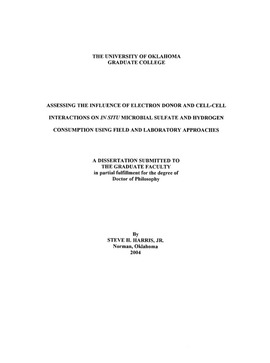| dc.contributor.advisor | Suflita, Joseph M., | en_US |
| dc.contributor.author | Harris, Steve H., Jr. | en_US |
| dc.date.accessioned | 2013-08-16T12:19:20Z | |
| dc.date.available | 2013-08-16T12:19:20Z | |
| dc.date.issued | 2004 | en_US |
| dc.identifier.uri | https://hdl.handle.net/11244/699 | |
| dc.description.abstract | *This dissertation is a compound document (contains both a paper copy and a CD as part of the dissertation). | en_US |
| dc.description.abstract | Information on in situ microbially-catalyzed reactions and the factors that influence those activities is required to accurately describe the transport and fate of both naturally occurring and contaminant forms of organic matter. While pure culture microbiological studies have provided insight on many phenomena, they are often difficult to extrapolate to more complex field settings. A combination of field and laboratory approaches proved useful for assessing differences in sulfate reduction rates at two locations in an aquifer contaminated by landfill leachate. The lack of activity in a downgradient location was not due to a deficiency in metabolic potential, sulfate availability, or quantity of dissolved organic matter (DOC). Rather, the quality of the DOC was such that it limited sulfate reduction at the distal site. | en_US |
| dc.description.abstract | Field determinations of the disposition of energy and materials ultimately depend on the interactions amongst microorganisms. The rate of hydrogen consumption by cocultures of Acetobacterium woodii and Methanospirillum hungatei could be described by a two-term Michaelis-Menten kinetic model, but the fate was consistently in favor of the methanogen. A heat-labile factor associated with whole cells, membranes, and cytoplasmic preparations of the acetogen was responsible for an amensalism between the organisms. This interaction allowed the methanogen to successfully compete for hydrogen even at cell densities that would normally preclude such activity. At low hydrogen concentrations, the threshold exhibited by A. woodii was independent of reaction thermodynamics as well as endproduct inhibition. Thus, hydrogen metabolism must be regulated by a mechanism different than previously hypothesized. Clearly, if such interactions are manifest in defined cocultures, it is reasonable to expect similar processes influence hydrogen metabolism in situ.* | en_US |
| dc.description.abstract | Given the importance of rate processes and the central role of hydrogen in anaerobic metabolism, comparable field methods were used to examine hydrogen turnover as an indicator of total community metabolism. Apparent first order rates in a number of redox zones in two aquifers differed by over three orders of magnitude and were negatively impacted by several environmental insults. Thus, such determinations have a necessary degree of sensitivity and may be an integrating gauge of in situ microbial activity. | en_US |
| dc.format.extent | xviii, 133 leaves : | en_US |
| dc.subject | Groundwater Pollution Oklahoma Norman. | en_US |
| dc.subject | Electron donor-acceptor complexes. | en_US |
| dc.subject | In situ bioremediation Oklahoma Norman. | en_US |
| dc.subject | Biology, Microbiology. | en_US |
| dc.title | Assessing the influence of electron donor and cell-cell interactions on in situ microbial sulfate and hydrogen consumption using field and laboratory approaches. | en_US |
| dc.type | Thesis | en_US |
| dc.thesis.degree | Ph.D. | en_US |
| dc.thesis.degreeDiscipline | Department of Microbiology and Plant Biology | en_US |
| dc.note | Source: Dissertation Abstracts International, Volume: 65-01, Section: B, page: 0066. | en_US |
| dc.note | Adviser: Joseph M. Suflita. | en_US |
| dc.note | Includes supplementary digital materials. | en_US |
| ou.identifier | (UMI)AAI3120038 | en_US |
| ou.group | College of Arts and Sciences::Department of Microbiology and Plant Biology | |
